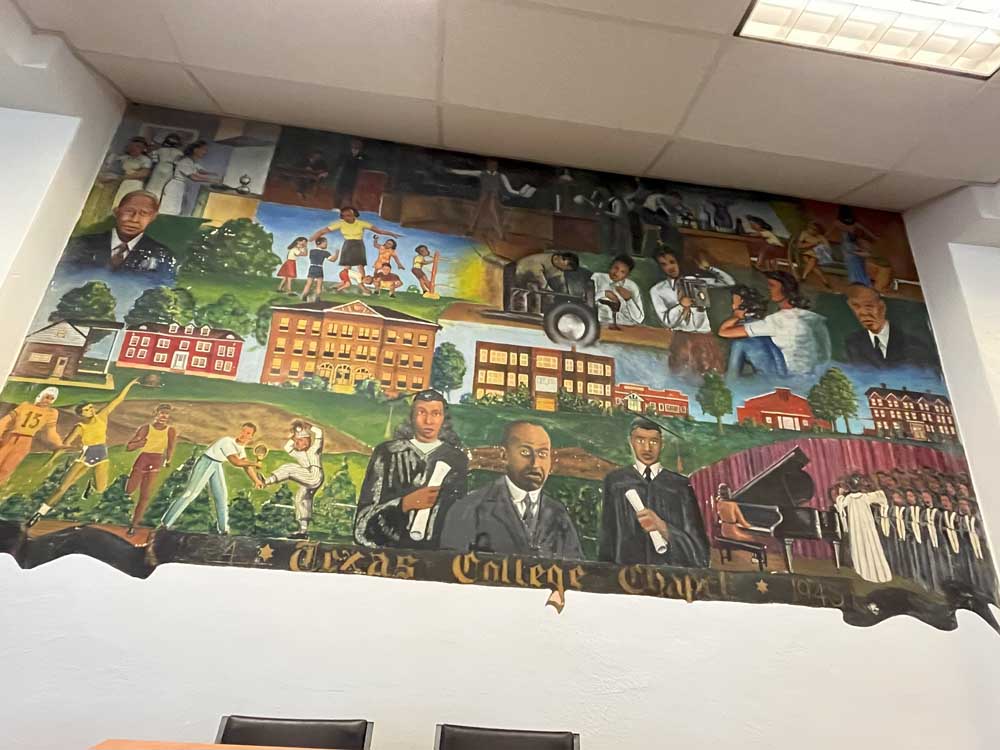Since 1894, Texas College in Tyler creates lasting impact
Published 5:45 am Friday, February 28, 2025

- A mural done by an art professor in 1943 depicts Texas College at that time. (Jennifer Scott/Tyler Morning Telegraph)
Editor’s Note: This is part of a series of stories celebrating Black History Month.
Born in an era of segregation but built on the promise of progress, Texas College in Tyler is carrying forward a legacy of excellence that remains as vital today as it was at the turn of the 20th century.
Trending
A legacy of education and access
Founded on Jan. 9, 1894, Texas College was established by ministers of the Colored Methodist Episcopal Church (now the Christian Methodist Episcopal Church) to provide educational opportunities for disenfranchised individuals in East Texas, according to information provided by the college. Located on 101 acres just north of Tyler, the college’s foundation symbolized a new era of higher learning in the region.
The college began in a four-room frame house with six students: Josie Jones, Sandy McKinney, William Anderson Redwine, Malinda Francis, T.K. Price, and R.K. Price. Despite limited resources and infrastructure at that time, students from across East Texas traveled to pursue their education.
Originally chartered as Texas College in 1907, the institution briefly changed its name to Phillips University in 1909, honoring Bishop Henry Phillips. However, in 1912, the name was reverted to Texas College, marking the beginning of decades of academic growth and expansion. By 1932, Texas College had achieved accreditation as a four-year institution.
Over the years, Texas College has expanded and modernized its campus, adding new facilities like a dormitory and the Connector while renovating existing buildings. Despite these changes, the college remains committed to preserving its historical legacy through four campus landmarks — two of which are listed on the National Register of Historic Places — as well as a 1943 mural depicting campus life at the time.
Among these landmarks are J.C. Martin Hall and the President’s House, which have long served academic and administrative purposes, along with the Gus F. Taylor Gymnasium and D.R. Glass Library, both central to student life and learning.
Trending
For 32 years, Texas College was the only institution of higher education in Tyler. When Tyler Junior College (TJC) was established in 1926, it did not admit Black students. In response, Texas College housed the TJC Branch for Negroes, later renamed Tyler District College, to provide educational opportunities for Black students. It continued until the integration in 1966.
In 1920, Texas College became a founding member of the Southwestern Athletic Conference (SWAC), one of the nation’s premier collegiate sports leagues. It was also a founding member of the United Negro College Fund (UNCF) in 1944, reinforcing its commitment to advancing education for Black students.
Community, tradition, and leadership
“I undoubtedly and proudly credit Texas College for who I am today,” said Jake Martin, Chief Marketing & Communications Officer and alumnus. “Immersed in a culture of cultures and immense diversity, I was exposed to excellence, afforded an unmatched wealth of knowledge, and provided contexts that shaped my identity and steered my interest toward a career in higher education.”
Texas College fosters a strong sense of connection among its students and alumni. Martin recalls how returning graduates shared invaluable oral histories, strengthening bonds between past and present students.
“The camaraderie during alumni events and the shared stories of those who walked this campus before us were impactful,” Martin said. “That’s what further engrained my love for Texas College — the community of alumni and students and jointly paying tribute to the institution that brought us all together and put us where we are today.”
For senior Roosevelt Williams, Texas College’s traditions deepen his leadership experience.
“As a student leader, I appreciate the opportunity to uplift and represent my peers in an environment that inherently understands and values our unique experiences,” Williams said.
Each Wednesday, students and faculty gather at the flagpole for prayer, reinforcing unity and shared values.
“This ritual fosters a sense of belonging,” Williams said, “allowing us to reflect on our faith and support one another.”
Texas College in the classroom
Dr. Edward Robinson, associate professor of history and religion since 2014, integrates Texas College’s legacy into his lessons, highlighting its role in broader historical movements.
“Texas College is unapologetically Black and unabashedly Christian, even as it welcomes people of all backgrounds,” Robinson said. “It stands as testimony to the resilience and determination of those who built it.”
As an educator, Robinson consistently integrates the history of Texas College into his classroom discussions. For example, when teaching about the Progressive Era (1890–1920) — a pivotal period when the U.S. population shifted from rural farms to urban centers — he highlights the college’s founding as part of that historical landscape. Established during this time, Texas College provided educational opportunities for Black youth and served as a guiding force in their academic development.
“One scholar has called the 1890s for African Americans the ‘nadir’ for Black Americans,” Robinson said. “In this repressive and oppressive environment, Black people toiled to improve life for themselves. Texas College stands as testimony to their resolve and determination.”
Notable alumni and lifelong ties
“Aside from educators, the college has a multitude of influential and trailblazing alumni across a variety of sectors that have played significant roles in advancing opportunities for Blacks and others,” Martin said.
Such notable alumni includes:
- Dr. Mildred Jefferson, the first Black woman to graduate from Harvard Medical School;
- Ms. Billye Suber Aaron, television personality, philanthropist, and wife of baseball legend Hank Aaron;
- Dr. Caroline Wanga, CEO of ESSENCE and one of Savoy’s Most Powerful Women in Corporate America;
- Ms. Irma P. Hall, actress known for Soul Food;
- Dr. Jesse W. Jones, Texas State Representative and the first person to earn a PhD in Chemistry from Arizona State University;
- Dr. Lillian K. Bradford, first Black woman to earn a doctorate from UT Austin and a National Science Faculty Fellowship recipient; and
- Dr. David R. Houston, local educator, administrator, and civic leader
Among these distinguished alumni is Rev. Dr. Orenthia Mason, who grew up across the street from Texas College, surrounded by its legacy. With multiple family members as graduates, attending Texas College was more than a choice — it was a continuation of tradition.
“My parents, aunts, uncles and cousins all went to Texas College,” Mason said. “I wanted to go where my mother went. There’s a deep family history and pride behind that.”
Her grandfather, Rev. L.W. Whitmore served as secretary of the Board of Trustees for 20 years, and Whitmore Hall on campus bears his name.
“Everybody that grew up in this area, we were a village,” Mason said. “All of the adults helped raise us. The leaders we admired and respected were from Texas College.”
Continuing the mission
“At the heart of it, the college remains an institution dedicated to providing a quality and comprehensive education to all who seek it,” Martin said. “And we remain committed to that.”
Under the leadership of President Dwight J. Fennell, Texas College continues to build on its legacy of academic excellence and inclusivity. From its historic campus to its deep-rooted traditions, the college remains a place where students from all backgrounds are welcomed, challenged, and prepared to lead.
“Our motto says, ‘Give the People Light and They Will Find Their Way,’” Martin said. “For over 131 years, Texas College has done just that.”





